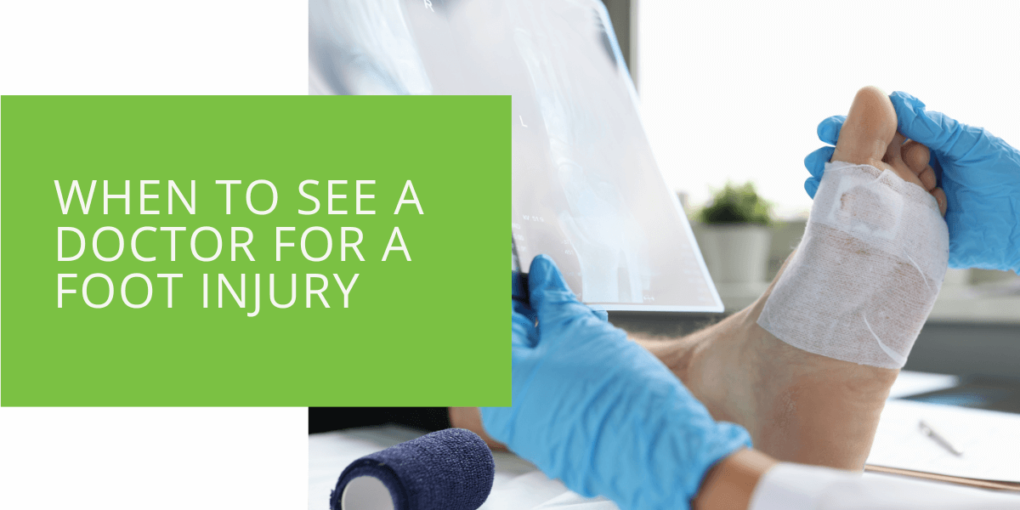When to See a Doctor for a Foot Injury
The foot and ankle are complex structures that are essential for mobility. When you experience pain or injury in these areas, it is important to seek the expertise of a foot and ankle specialist. A podiatrist is a doctor who specializes in foot care and can provide treatment for various foot injuries, from sprains and fractures to bunions and infections. If you have a more severe injury, such as a deformity or trauma, a podiatric surgeon can help get you back on your feet.
Signs that Indicate a Foot Injury Needs Medical Attention
Foot injuries can be painful and disruptive to daily life. While some injuries can be treated at home, others require medical attention. Here are some signs that indicate when you should see a doctor for a foot injury:
Severe Pain
Severe pain is a common symptom of many foot injuries, such as fractures, sprains, or ligament tears. It can be a sharp or dull pain that doesn't go away or gets worse over time. Different treatment options may be available depending on the severity and type of injury. Immobilization, physical therapy, or surgery may be necessary to alleviate the pain and promote healing.
Swelling and Redness
Swelling and redness are common symptoms of foot injuries and can be caused by various conditions, such as infections, allergies, or autoimmune disorders. In some cases, the swelling and redness may be localized to the injured area, while in others, they may be more widespread. If left untreated, swelling and redness can lead to more serious complications, such as tissue damage or abscess formation. Depending on the underlying cause, different medications may be used to treat these conditions. Antibiotics, antihistamines, or corticosteroids may be prescribed to reduce swelling and redness and promote healing.

Numbness or Tingling
Numbness or tingling in the foot can be a sign of nerve damage, which various conditions, such as peripheral neuropathy or nerve compression, can cause. It can also be a symptom of other underlying medical conditions, such as diabetes or arthritis. If left untreated, nerve damage can lead to more serious complications, such as muscle weakness or paralysis. Different diagnostic tests may be used to evaluate the condition depending on the type and severity of nerve damage. Nerve conduction studies or electromyography may be used to assess the extent of nerve damage and determine the best course of treatment.
Inability to Bear Weight
The inability to bear weight on the injured foot is a common symptom of many foot injuries, such as fractures, sprains, or dislocations. It can be a sign of a serious injury that requires immediate medical attention. Different treatment options may be available depending on the type and severity of the injury. Rest, ice, compression, and elevation (RICE) therapy may reduce pain and swelling. In some cases, weight-bearing exercises or gait training may be necessary to regain mobility and strength.
When to Seek Emergency Medical Attention
While many foot injuries can be treated outpatient, some require immediate medical attention. Here are some signs that indicate when you should seek emergency medical attention for a foot injury:
Bone Protruding Through Skin
If you have an open wound with bone protruding through the skin, it is a medical emergency that requires immediate attention. This is a sign of a severe fracture that has caused a bone to break through the skin. This type of injury is known as an open fracture, and it can lead to serious complications, such as infection or nerve damage. Emergency medical treatment is necessary to clean and stabilize the injury and prevent further complications. A podiatrist can refer you to an appropriate specialist, such as a podiatric surgeon, for surgical treatment.

Excessive Bleeding
If your foot injury is bleeding excessively and you are unable to control the bleeding, seek emergency medical attention. Various conditions, such as a puncture wound, laceration, or avulsion, can cause excessive bleeding. It can lead to serious complications, such as shock or hypovolemia, if left untreated. Emergency medical treatment is necessary to stop the bleeding and prevent further complications. Different treatment options may be available depending on the type and severity of the injury. Stitches, staples, or surgery may be necessary to close the wound and promote healing.
In addition to these signs, it is important to seek emergency medical attention if you experience any of the following symptoms:
- Numbness or tingling in the foot or toes
- Severe pain that doesn't go away or gets worse over time
- Inability to move the foot or toes
- Joint deformity or misalignment
- Diabetic foot complications, such as ulcers or infections
Emergency medical treatment can help prevent further damage and promote healing. If you experience any of these symptoms, seeking emergency medical attention as soon as possible is important.
Conclusion
Foot injuries can be painful and disruptive to daily life. Knowing when to see a doctor for a foot injury can make a difference in the healing process and can prevent further damage. If you experience any of the signs mentioned in this article, seeking medical attention is important.

